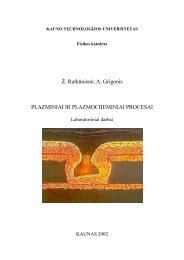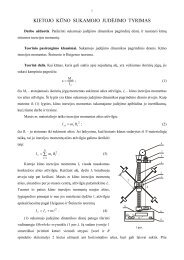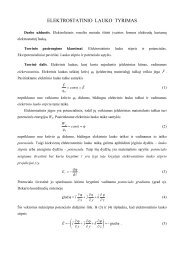PROCEEDINGS OF THE 7 INTERNATIONAL ... - Fizika
PROCEEDINGS OF THE 7 INTERNATIONAL ... - Fizika
PROCEEDINGS OF THE 7 INTERNATIONAL ... - Fizika
You also want an ePaper? Increase the reach of your titles
YUMPU automatically turns print PDFs into web optimized ePapers that Google loves.
MEDICAL PHYSICS IN <strong>THE</strong> BALTIC STATES 7 (2009)<br />
Proceedings of International Conference “Medical Physics 2009”<br />
8 - 10 October 2009, Kaunas, Lithuania<br />
ULTRAVIOLET RADIATION INFLUENCES WETTABILITY AND BIOLOGICAL<br />
PROPERTIES <strong>OF</strong> PMMA SURFACE<br />
Yuri DEKHTYAR 1 , Linda LANCERE 1 , Nataliya POLAYKA 1 , Alexander RAPOPORT 2 , Anna RUSAKOVA 2 ,<br />
Alexander SUDNIKOVICH 2 , Valdis VALTERS 3<br />
1 Riga Technical university, 2 University of Latvia, 3 Valter’s Prosthetic laboratory, ltd.<br />
Abstract: PMMA (poly-methyl metha acrylate) material is widely used for eye prostheses. During its exploitation the<br />
material is under sun radiation, ultraviolet (UV) being the component. Therefore the properties of PMMA influenced by<br />
UV could affect biocompatibility of the prostheses. The present article is targeted to explore influence of UV on<br />
wettabilty and biological properties of PMMA<br />
Keywords: PMMA, ultraviolet radiation, sun radiation, eye prostheses<br />
1. Introduction.<br />
The tear liquid should moisten the PMMA eye<br />
prosthesis during its exploitation. This could be<br />
disturbed by sun ultraviolet, strong radiation destroying<br />
molecular couples of the PMMA [1, 3, 5, 6]. Currently<br />
there are not experimental data on the soft Sun UV<br />
influence on PMMA wettability properties.<br />
The article is targeted to explore influence of the<br />
simulating sun UV radiation on the PMMA wettability.<br />
The latter could be influenced because of the chemical<br />
alteration induced by UV [1, 3, 5, 6] or just because of<br />
the escaping electrons from the surface layer<br />
(photoemission). As the result the surface should<br />
acquire an electrical charge. To verify this, the electron<br />
work function of the radiated specimens was measured.<br />
Disturbance/damage/reconstruction of chemical couples<br />
at the PMMA surface could have a negative influence<br />
on the cell behaviour. Taking this into account, the<br />
viability of the yeast eukaryotic cells deposited on the<br />
radiated specimens was tested too.<br />
2.1. Radiation<br />
2. Methods and materials.<br />
For physical simulation process, samples from<br />
commercial material “Stoma” (Ctoma) were taken with<br />
size of ~1x1cm 2 , thickness about 2-4mm.<br />
The UV irradiation was supplied from the Hamamatsu<br />
Spot Light Source equipped with Hg-Xe lamp (intensity<br />
at the source exit was 3500mW/cm 2 at wavelength<br />
365nm), the specimens were placed at 0,4 m distance<br />
from the source exit. The room air was the environment<br />
69<br />
for the specimens. The room temperature was +20 0 C +/-<br />
2 0 C and humidity 39+/-7mmHg.<br />
The temperature at the specimen’s surface during the<br />
radiation was not higher as in the room.<br />
Before radiation each specimen was cleaned with 96%<br />
ethanol.<br />
2.1. Measurements of wettability<br />
Wettability was tested by the modified Axisymmetric<br />
Drop Shape Analysis-Profile (ADSA-P) drop method<br />
before and after the UV exposure. The physiological<br />
solution was used as the testing liquid. The drop with<br />
diameter ~10mm was measured using the optical<br />
microscope MMI-2 (MMИ-2). The image of the drop<br />
was projected via CCD camera (Imaging Source) to the<br />
PC screen. The contact angle was measured from<br />
images applying in the Photoshop software CS3<br />
version. Before measurements each sample was cleaned<br />
with 96% ethanol. The above described sequence was<br />
repeated 15 times for each sample to collect statistics.<br />
2.2. Electron work function.<br />
The electron work function (ϕ) was determined as the<br />
result of the pre-threshold photoelectron emission<br />
measurements. For this each specimen was positioned in<br />
the hand made spectrometer [8] and photoelectron<br />
emission current was detected in dependence on the<br />
photon energy in a range 4-6 eV. The duration<br />
(exposure) of the experiment was several times less in<br />
contrast to the above radiation of the specimens.








